
 |
The Spring aurora season is winding down, the days are getting longer and the nights are getting shorter, soon the ever increasing magnitude of the twilight glow will bring a halt to proper dark sky aurora hunting until late Summer. Despite these growing natural obstacles it's important to never give up and make the most of the limited dark skies we have, after all, nature loves to give us a surprise when we least expect it. During this particular period there was nothing exceptional happening regarding geomagnetic activity, however it was far from quiet.
NOAA had mentioned the prospect of a series of faint slow moving CMEs arriving during this period while in the background a gentle solar wind from a CH was enhancing levels. G1 conditions were the most optimistic of the forecasts while others used the more timid terminology of 'active levels'. In any event the night of Friday April 26th was forecast to be clear all night long with a waning full moon rising after 01.30 which meant I had quite a few hours of dark moonless sky to enjoy before moonrise. I came close to letting it go and just stay home as I was planning an early morning rise the following day for drone filming at the north coast so a night of good rest would have been the smart thing to do. However, the prospect of a clear dark night beckoned and my hunter instincts were stirring big time.
I actually had an ulterior motive which wasn't aurora related in the form of a new comet designated C/2023 A3 Tsuchinshan-ATLAS which I was eager to see visually for the first time. I had just finished observing 12P/Pons-Brooks after months of observations, the comet was now lost in solar glare and in the process of diving into southern hemisphere skies. I managed to glimpse the comet with the naked eye and enjoyed its dynamic ion tail, then as the comet dived into the solar ocean never to re-surface my full attention turned to C/2023 A3, which was now getting into visual range. This comet has an orbit which will bring it inside the orbit of Mercury later this year so it will be making a close approach to the sun, then by mid October it will emerge from the sun and into the evening twilight when it may be a bright naked eye object with a striking tail.
The comet could reach mag 0 or -1 at perihelion but due to forward scattering it could become enhanced to mag -2 to -4, possibly visible in broad daylight to trained observers. If this actually comes to pass then we could have a 'Great Comet' in our skies and possibly the brightest comet from the northern hemisphere in 27 years since Hale-Bopp in 1997 (the one which got me hooked on the night sky). I have been monitoring this comet since it was first discovered during January last year and I've been reading everything about its progress since, it has generated much excitement among comet lovers with the community divided over the comet's future.
However this is all getting ahead of ourselves, naturally I have been buzzing with excitement over this one as I've been patiently waiting for a great comet in our skies once again. The comet was being detected by CCD over the last few months however now it was getting within a comfortable visual range for any modest amateur telescope and I was eager to make my very first observation when the time was rite, that time was tonight. My goal was to see the comet then keep an eye out for aurora activity and perhaps do a little astrophotography too. I checked the aurora charts, the stats were not exciting, solar wind over 340km/sec however the Bz was negative which was always a good thing. I decided to just adopt a positive attitude, I would go out anyway expecting very little and if anything showed at all it would be the icing on the cake. This was a night of low expectations, it was just meant to be quality time spent under the stars to enjoy a wonderful clear night.
I packed my Meade 10" F/5 Dobsonian reflector into the van along with my camera gear, the sun was setting in a perfect clear sky, I wrapped up warmly, -3C was forecast, then after 22.00 I began the drive into the Sperrins during evening twilight. I arrived at Beaghmore and pulled over in a lay by beside a picnic table and got outside to check the sky and get dark adapted. The sky was 100% clear with not a cloud in sight and very transparent, in fact, this was the best night I had seen for some time. I eagerly set-up the telescope to let it cool down then did a naked eye dome search. After 15 min's the darkening twilight was improving so to get my eyes adjusted to faint objects I observed a few random Messier objects. M13, M92, M81, M82, Leo Triplet, M51, M101, and the Coma-Virgo cluster. Then I turned the scope to the SE towards Virgo and guided the scope slowly below a naked eye star in the NE section of that constellation, two min's later I found the comet at 22.45!
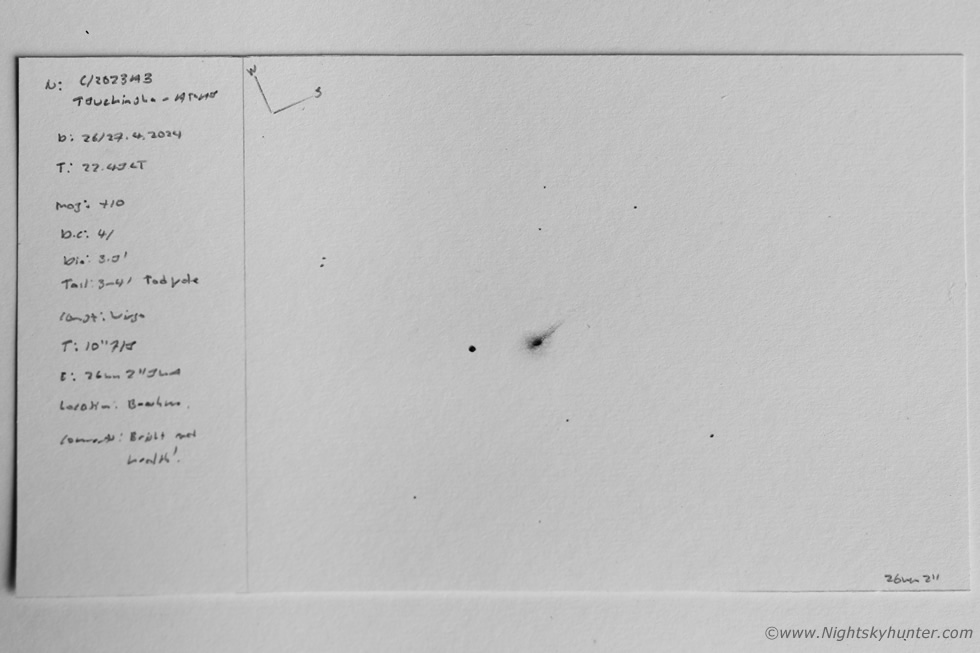 |
The comet was easy to see as a compact fuzzy oval with a bright stellar condensation. The coma was moderately condensed at DC:4, maybe slightly stronger, and I was shocked to see a slender dust tail streaking off to the NE shaped like a tadpole. I was absolutely delighted to have seen it for the first time, the night had been a success already and darkness was only just falling. My initial impression was that the comet looked bright and healthy, mag +10, if it keeps this up then perhaps we will get a treat in October after all. Above is a crude sketch made of the eyepiece field from memory.
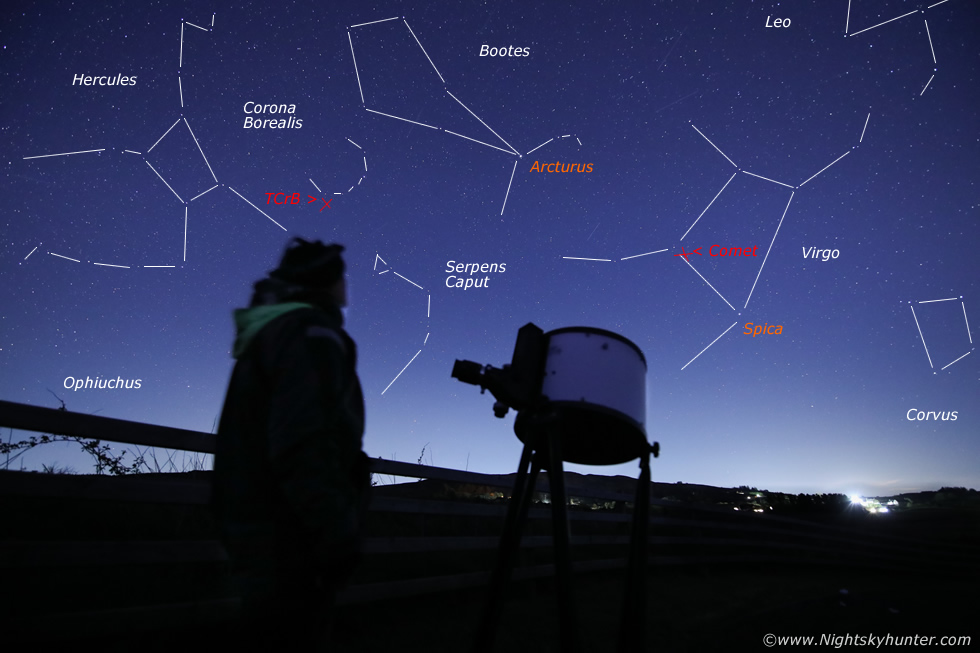 |
I then turned my gaze to the E and did my nightly naked eye check of Corona Borealis where the recurrent Nova TCrB is waiting to erupt into naked eye visibility any night now. It was still invisible tonight, however if past trends are anything to go by this binary star system could flare up to mag +3 or +2 within a matter of hours in classic Nova fashion, this could happen tonight, tomorrow night, or next week, predictions are forecasting the eruption between April and September this year. I set up the DSLR and took this wide angle image of me and the scope with the main constellations annotated, I also marked the positions of TCrB and the comet in red.
Content with my visual observations I packed the scope away then took an exposure to the north, the camera revealed a faint auroral glow hidden from the eye. Feeling encouraged I went into aurora hunting mode and got back in the van and drove further along the back roads of Beaghmore, I wanted to re-visit an old friend in the form of an isolated tree which Roisin and I had spotted years ago, we simply called it the fairy tree. I arrived, walked to the middle of two large fields where the tree was located in complete isolation then began taking test images.
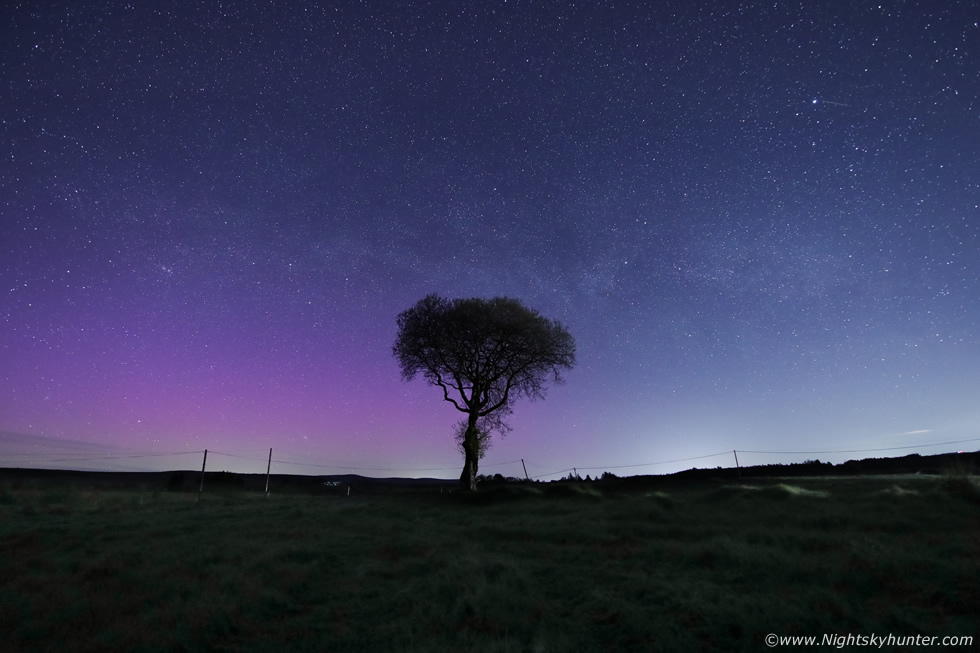 |
The camera picked up a beautiful auroral glow with purple-pink colours which looked really nice with the rising Milky Way in the NE/E sky. I then found another composition and decided to shoot a time lapse of the tree and sky. I knew the aurora was very weak and hardly photogenic however it had been so long since I shot a night lapse I decided to go for it anyway as there was nothing to loose. As the camera took 8 sec expsoures one after the other I stepped back and got dark adapted and just enjoyed the sky. The atmosphere was absolutely stunning, the night was dead calm and silent, the only noise I could hear was from the motion of running water from a distant stream. From out here in the middle of nowhere the sky was dark and the stars were sublime.
For the next two hours I stood in this dark field observing, I obtained the best dark adaption in years, then did a naked eye scan of the entire sky going over every constellation and star I had put to memory over the years. It was so peaceful that on occasion my mind would wonder off into a day dream, or I should say a night dream, I imagined what TCrB would like and I fantasized about great comets and what C/2023 A3 might look like low in the sky to my SW. During the course of these two hours I noticed a very faint enhancement to the N-NW sky which seemed to wax and wane, this was the aurora the camera was detecting, my goodness was it faint, I reckoned not too many people were seeing it with ease without equipment. Sometimes vertical forms would appear which were so subtle there were dream-like, almost imaginary, rite on the threshold of naked eye range, these were extremely faint auroral pillars.
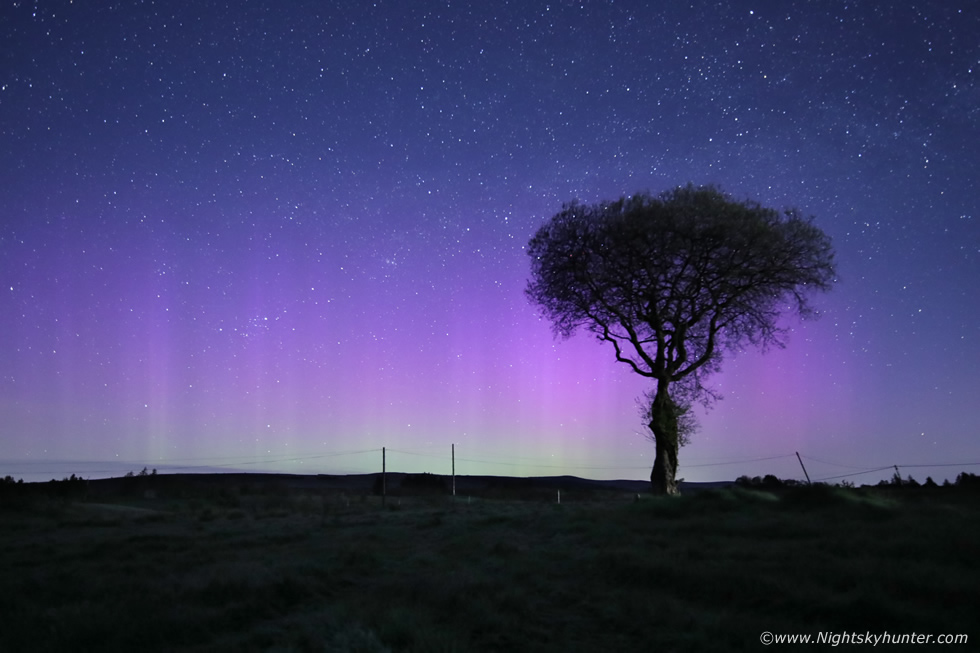 |
Sometime after midnight, around 01.00, that glow grew brighter, then from nowhere a formation of broad ghostly pillars of pale light suddenly appeared, first one, then two then a dozen, the aurora had come to life, the beams reached 20 degrees high and where concentrated within Cassiopeia, Perseus and Auriga. I know this wasn't a great display, likely not even G1 levels, however when you have been standing here with exceptional dark adaption for over 2.5 hours it felt fabulous to witness, it felt special, I had earned it, it was like Mother Nature's way of rewarding me and I got that warm buzz I always get when I see something special in the sky.
To me this aurora was personal, intimate, and I was more than happy with its performance. Actually it was surprisingly photogenic too, I lifted the camera and changed to another angle and began taking images. 6 sec's at ISO8000 with 15mm F/2.8 lens on full frame DSLR. I then zoomed in from 15mm to 20mm, still at F/2.8, to isolate the beams with the fairy tree. I was really happy with this image, simplicity and no clutter, complete isolation, one foreground element with the sky doing all the talking, this was my kind of scene.
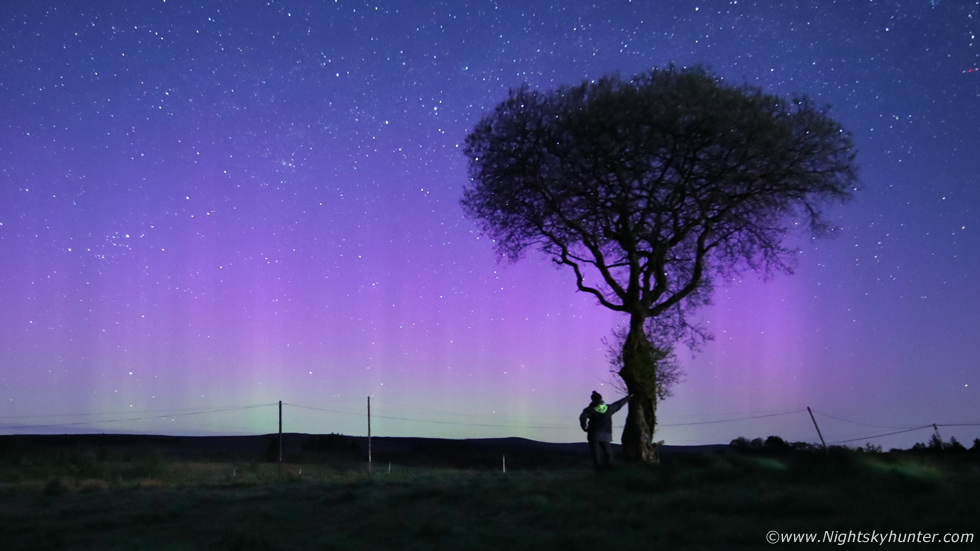 |
I had to get a selfie, something I don't do very often, so I walked into the scene and leaned against the tree while I watched those pillars form and vanish like apparitions over the silent landscape.
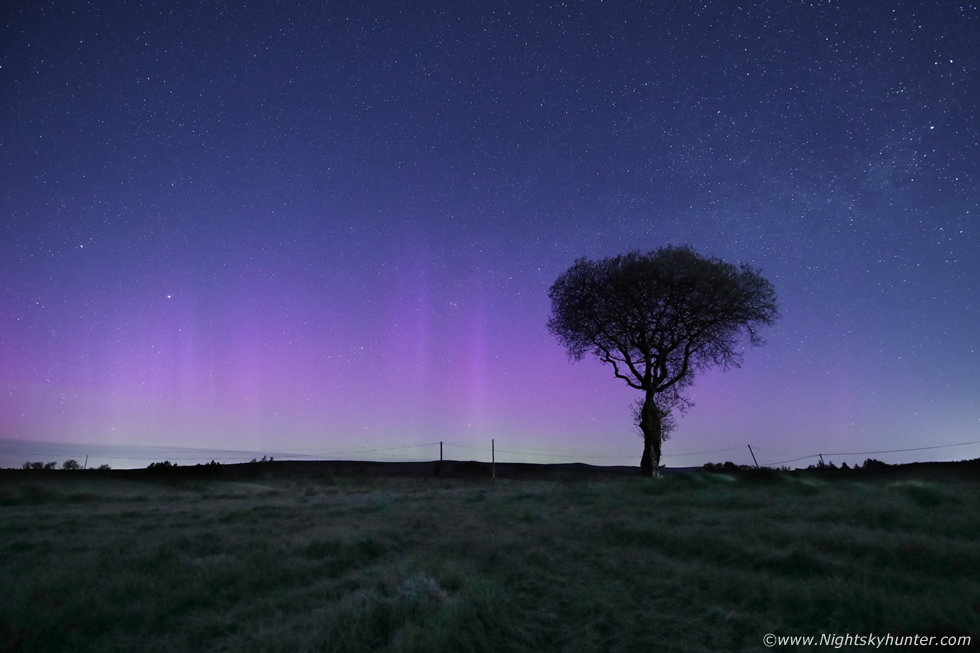 |
Full wide angle at 15mm, the aurora was at its peak and the moon was rising low on the horizon behind me as a pale orange gibbous giant dimly illuminating the frosted grass in the field. Then as if a curtain had been drawn the pillars disappeared and the show was over. I was really chuffed with this lovely little surprise and feeling content I made my way back to the van, which was reading -5C, got warmed up, then headed back home to a warm bed. I couldn't have asked for a better night with auroras and comets. Back in bed I thought about that fuzzy comet and its slender tail and wondered what it would look like in October, then I fell asleep. Thanks very much for reading.
Martin McKenna